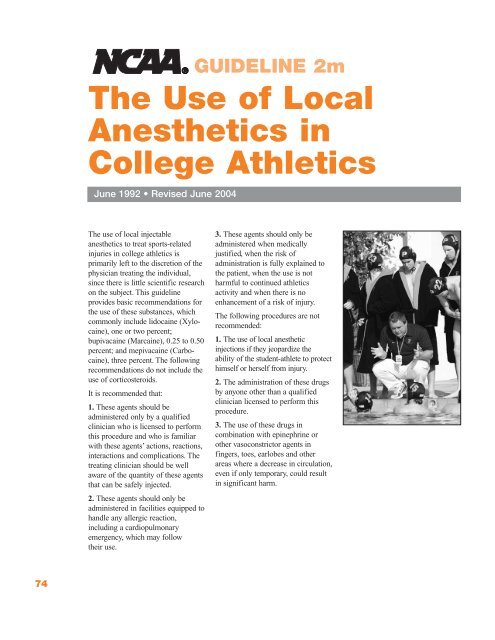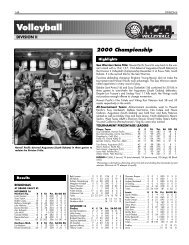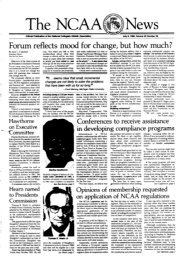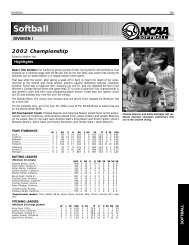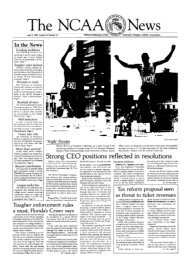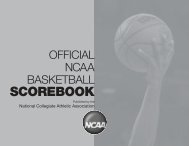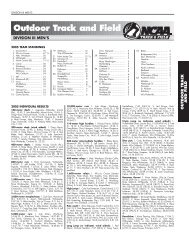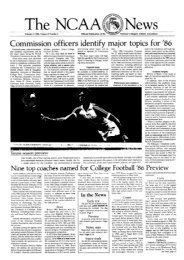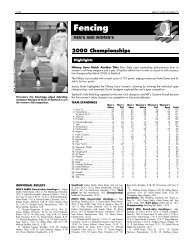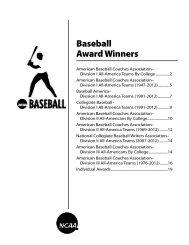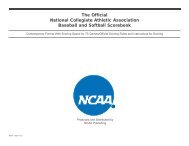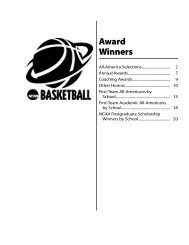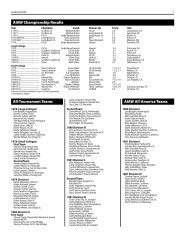Sports Medicine Handbook - NCAA
Sports Medicine Handbook - NCAA
Sports Medicine Handbook - NCAA
You also want an ePaper? Increase the reach of your titles
YUMPU automatically turns print PDFs into web optimized ePapers that Google loves.
74<br />
The use of local injectable<br />
anesthetics to treat sports-related<br />
in juries in college athletics is<br />
primarily left to the discretion of the<br />
physician treating the individual,<br />
since there is little scientific research<br />
on the subject. This guideline<br />
provides basic recommendations for<br />
the use of these substances, which<br />
commonly include lidocaine (Xylocaine),<br />
one or two percent;<br />
bupivacaine (Marcaine), 0.25 to 0.50<br />
percent; and mepivacaine (Carbocaine),<br />
three percent. The following<br />
recommendations do not include the<br />
use of corticosteroids.<br />
It is recommended that:<br />
1. These agents should be<br />
administered only by a qualified<br />
clinician who is licensed to perform<br />
this procedure and who is familiar<br />
with these agents’ actions, reactions,<br />
interactions and complications. The<br />
treating clinician should be well<br />
aware of the quantity of these agents<br />
that can be safely injected.<br />
2. These agents should only be<br />
administered in facilities equipped to<br />
handle any allergic reaction,<br />
including a cardiopulmonary<br />
emergency, which may follow<br />
their use.<br />
GUIDELINE 2m<br />
The Use of Local<br />
Anesthetics in<br />
College Athletics<br />
June 1992 • Revised June 2004<br />
3. These agents should only be<br />
administered when medically<br />
justified, when the risk of<br />
administration is fully explained to<br />
the patient, when the use is not<br />
harmful to continued athletics<br />
activity and when there is no<br />
enhancement of a risk of injury.<br />
The following procedures are not<br />
recommended:<br />
1. The use of local anesthetic<br />
injections if they jeopardize the<br />
ability of the student-athlete to protect<br />
himself or herself from injury.<br />
2. The administration of these drugs<br />
by anyone other than a qualified<br />
clinician licensed to perform this<br />
procedure.<br />
3. The use of these drugs in<br />
combination with epinephrine or<br />
other vasoconstrictor agents in<br />
fingers, toes, earlobes and other<br />
areas where a decrease in circulation,<br />
even if only temporary, could result<br />
in significant harm.


